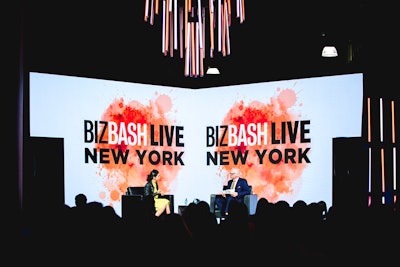
Event professionals from brands and production companies such as BMW, Industria Creative, the Soze Agency, and Mirrored Media recently shared their viewpoints on a number of industry topics at the Event Innovation Forum, workshops, and master classes at BizBash Live: New York, which took place October 24 at the Jacob K. Javits Convention Center. Here are their tips for how to make attendees connect at events, create data-driven and culture-changing experiences, how to reach millennials in interesting ways, and more.
1. Create a defining moment.
Nicole Halton, director of special projects for the Natural Resources Defense Council, said events are all about a defining moment—and creating one is a big step in rethinking event strategy. “We can create more defining moments with elevation, pride, insight, and connection,” said Halton. “Put those into every experience you’re creating. You want to raise the stakes. Are guests pulling out their phones, wanting to capture the event? That’s your goal.”
Laura Hutfless, partner at FlyteVu, added to this tip, saying that planners should start with the headline and work backwards: “What’s the headline you want after the event?”
An event’s design should create defining moments, and they don't happen by accident, said David Solsbery, vice president of creative and marketing for Hargrove, in a session on design thinking. He added that an event isn’t about the budget, it’s about how one designs the experience.
2. When planning events for social good, be authentic.
Michael Skolnik, co-founder of the Soze Agency, spoke about launching Immigrant Heritage Month in 2015 and creating pop-up experiences celebrating immigrant heritage in 2017. The pop-ups, which were called I Am An Immigrant, offered community engagement programs, free T-shirts with the event name, an evening program featuring recipients of the Deferred Action for Childhood Arrivals (DACA), and food created by immigrant and refugee chefs.
“As we curate these spaces, everything we try to bring into the space is authentic to the issue we’re working on. Brands are looking for authentic connections to their consumers, and nonprofits are looking for places to build community,” said Skolnik. “If you don’t believe in the event you’re creating, maybe you shouldn’t be doing it. [It’s okay] to forget the event results if you embrace and love the process.”
3. When creating event attendee data, think about three key areas: profile data, engagement data, and behavioral data.
Events generate a lot of data, which is important, but often event agencies aren’t clear on what they should be doing with that data and aren’t necessarily putting purpose behind it, said Ken Madden, senior vice president of digital engagement for George P. Johnson.
Madden said it’s helpful to think about data in the three key areas of a profile (building personas and knowing who attendees are), engagement (how attendees interact with the event), and behavioral (tracking attendees around the space, knowing where they go and when.)
“Always think about the user, and build objectives across the entire user journey,” said Madden. “Remember, the event is just the middle of the journey. Prioritize the data with the biggest impact—what are one or two key pieces of data that will give me the most value? Create meaningful tests, deploy those, and evolve them.”
[PULLQUOTE]
4. Event planners have a responsibility to create specificity and disputability for an event.
Priya Parker, author of The Art of Gathering, shared how to create gatherings where attendees are connecting in a meaningful way. Parker said that events should be specific and disputable, meaning there should be a clear purpose and an option to change or evolve. She said that many event planners got into the field because they care about community and have been moved by gatherings; but over time, a lot of the work ends up being about logistics. She advised planners to first ask the question: What is the purpose of the event, or what should it be?
“To me, the creation of an event is a sacred process. You can create a temporary, alternative world of what something could be like,” Parker said. “What is worth bringing people together and having them pay attention? And ask, could this happen outside of this room?”
Part of the artistry of planning a gathering is to educate your client, Parker said. “It’s your job to educate them and bring your expertise as to why some gatherings take off and some don’t,” she said. “You want to train teams and companies to think: Every time you gather, how do you do this in a way so that the gathering is transformative?”
5. Brands should look at what consumers want and put them first—rather than the brand itself.
Erica Boeke, former vice president of experiential at Condé Nast's CNX, said consumers should be a brand’s number one priority when aiming to create a culture-changing experience.
“It’s all about the user experience,” said Boeke. “What do you want your tribe to feel? What do you want your tribe to get out if it? And what timing works for your tribe?”
Boeke also explained the importance of building community from the event, and that the event’s end should be just the beginning. “Thank attendees, ask them what they want, and listen,” she said. Providing them with some sort of takeaway, sending them digital newsletters, and inviting them to private Facebook groups, are some ways to keep them informed and connected, she said.
6. Reach millennials through a variety of platforms.
Justin Lefkovitch, founder and C.E.O. of Mirrored Media, and Eric Vicedomini, marketing communications manager for BMW North America, gave a presentation about this year's Road to Coachella, a campaign that aimed to bring attendees together and highlight what made them the same—on a figurative and literal road to the festival.
The campaign, which hired 17 influencers to drive custom-wrapped BMW i vehicles and document their experience, reached millennials in multiple ways.
“We wanted everyone to open up Instagram and see the campaign coming from multiple sources,” said Lefkovitch. “We wanted everyone to get to be a part of this, and know that this happened.” Social posts, influencer strategy, video content, and live events were ways the brand and the agency brought the campaign to life.
7. How to get multicultural marketing right: Respect, connect, and empower.
Anthony Larrisey, principal and creative director of Industria Creative, spoke about how experiential marketers can effectively celebrate diversity and inclusion. Three ways to get multicultural marketing right, he said, are to be respectful, make connections, and to empower the audience.
Larrisey illustrated these three ways through presentations about recent projects Industria Creative produced, including a series of queer and fashion influencer events for FX’s American Crime Story: The Assassination of Gianni Versace.
“It’s important to leverage trends and movements, and pay attention to what’s going on in the cultural [moment]. The benefit is relevant offers, greater strategic advantage over competition, and deeper engagement with consumers,” he said. “Diversity and inclusion is no longer an option, but a necessity.”



















